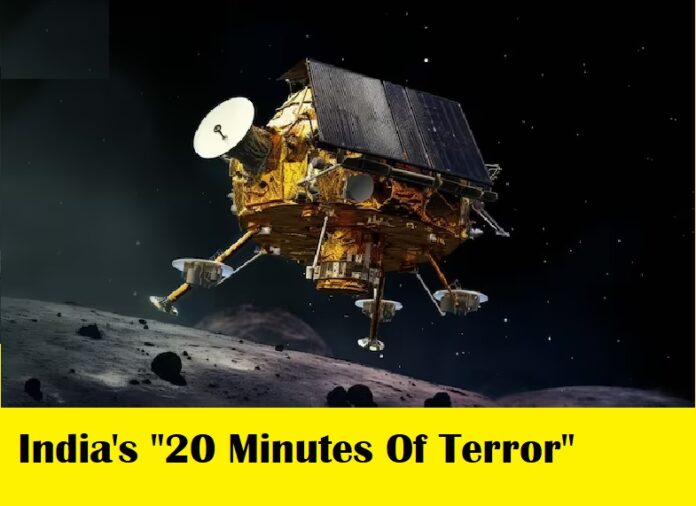India’s “20 Minutes Of Terror”: Chandrayaan-3’s Moon Landing Chandrayaan-3 is all set to make history as it tries to soft land the Vikram Lander with the Pragyaan rover in its belly close to the moon’s south pole.
On Wednesday, when the Vikram lander attempts to make a gentle landing on the surface of the moon in the evening, the country will endure one of the most painful twenty minutes.
Chandrayaan-3, an Indian spacecraft, is prepared to make history when it tries to soft-land the Vikram Lander with the Pragyaan rover in its belly close to the south pole of the moon. Its terrifying final 20 minutes of travel have been compared to the suspenseful conclusion of a T-20 match in terms of tension.
Journey and landing of Chandrayaan-3
Chandrayaan-3 was launched into orbit by ISRO’s Bahubali rocket or Mark-3 launch vehicle following an impressive liftoff. Chandrayaan-3 made several elliptical orbits around the Earth while gathering speed.
Chandrayaan-3 began its 3.84 lakh kilometer trek toward the moon on August 1. The Chandrayaan-3 satellite settled into its orbit above the moon on August 5. The Chandrayaan-3 was stabilized for several days in the lunar orbit.
On August 17, while the satellite was in an orbit measuring 153 km by 163 km, the propulsion module and the Vikram lander with Pragyaan rover separated in a key and challenging operation. In a 153 km by 163 km orbit around the moon, the propulsion module keeps going.
Before the powered fall can start, the Vikram lander will soon be pushed closer to the moon’s surface in a 134 km by 25 km elliptical orbit. India has completed this process in Chandrayaan-2 successfully up to this point.
The twenty minutes of terror, or T-20, begin on the day of landing, setting up a suspenseful conclusion. The Vikram lander will start descending towards the moon’s surface from a height of 25 km upon receiving commands from Bengaluru.
The powered fall of the Vikram lander will send it hurtling into the moon’s surface at a speed of 1.68 km/s, or approximately 6048 km/h—almost ten times that of an airplane.
This is known as the rough braking phase and lasts for roughly 11 minutes. The Vikram lander will then begin to slow down with all of its engines operating, but the lander is still practically horizontal to the surface of the moon.
The ‘fine braking phase’ will start once the Vikram lander is made vertical to the moon’s surface through a series of maneuvers.
The Vikram lander during the Chandrayaan-2 launch lost control and crashed while in the fine braking phase.
The Vikram lander floats over the lunar surface while inspecting the landing strip at 800 meters above the lunar surface, when both the horizontal and vertical velocities are zero.
The Vikram lander descends much farther before coming to a stop and hovering once again at a height of 150 meters while collecting photos to identify hazards and find the ideal landing spot.
With just two engines operating, it will then touch down on the lunar surface. The legs were built to withstand an impact of up to 3m/s, or roughly 10.8 km/h.
The engines will shut down after the legs’ sensors detect the lunar surface, putting an end to the terrifying 20 minutes.
It is permitted for the regolith, or lunar dust, that was stirred up by the landing to disperse and settle. The ramp then starts to open up. The Pragyaan Rover is gradually lowered.
When the Pragyaan Rover touches down on the lunar surface, it is then free to explore the surface.
The big moment occurs when the Vikram lander and Pragyaan rover both take pictures of the lander, beaming back to India the first selfies taken by India on the lunar surface.
Now that the Vikram lander and rover are solar-powered and designed to endure one lunar day, which is equivalent to 14 Earth days, the real science can start.
Send in a remark If everything goes according to plan, India would be the fourth nation to gently touch down on a celestial body. In the “Amrit Kaal,” India made one great leap while ISRO took a tiny one. Truly a magnificent ‘Hanuman’ leap for a nation of 1.4 billion people.


